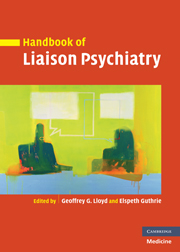Book contents
- Frontmatter
- Contents
- List of contributors
- Preface
- Part I Basic skills
- Part II Common psychiatric problems across the general hospital
- Part III Working with specific units
- Part IV Treatment
- 33 Psychopharmacological treatment in liaison psychiatry
- 34 The role of psychological treatments
- 35 Problem cases
- Part V Different treatment settings
- Index
- References
34 - The role of psychological treatments
from Part IV - Treatment
Published online by Cambridge University Press: 10 December 2009
- Frontmatter
- Contents
- List of contributors
- Preface
- Part I Basic skills
- Part II Common psychiatric problems across the general hospital
- Part III Working with specific units
- Part IV Treatment
- 33 Psychopharmacological treatment in liaison psychiatry
- 34 The role of psychological treatments
- 35 Problem cases
- Part V Different treatment settings
- Index
- References
Summary
Introduction
Physical illness is associated with worry and uncertainty. People react differently to illness, and their distress can seldom be adequately conceptualized in purely biomedical terms. Coping with illness is a dynamic process, which changes over time. People need to manage the initial emotional shock of diagnosis, assimilate information, construct an understanding of the illness, and the limitations or the demands it imposes upon them, and formulate ways to cope. Major illness often requires patients and their families to re-evaluate their lives and make substantial changes.
General principles
Why psychological interventions?
Everyone's response to illness is different and is shaped by their own unique experience of the world. People's reaction to illness depends much more on psychological factors than factors directly attributable to the disease (Sensky & Catalan 1992). This applies particularly to anxiety and depression. Both are common among people with physical illnesses, and are influenced more by the person's appraisal of his or her circumstances than by factors related to the disease, such as severity of symptoms or prognosis. The same is true of suffering. Suffering can be understood as a perceived threat to the person's self (Cassell 1982), and such threats are common in physical illness (for example, a threat to physical prowess caused by arthritis or obstructive airways disease, or a threat to body image resulting from cancer).
Factors common to all psychological approaches in physical illness
All psychotherapies consist of two elements; professional service and personal attachment.
Keywords
- Type
- Chapter
- Information
- Handbook of Liaison Psychiatry , pp. 795 - 817Publisher: Cambridge University PressPrint publication year: 2007
References
- 6
- Cited by

